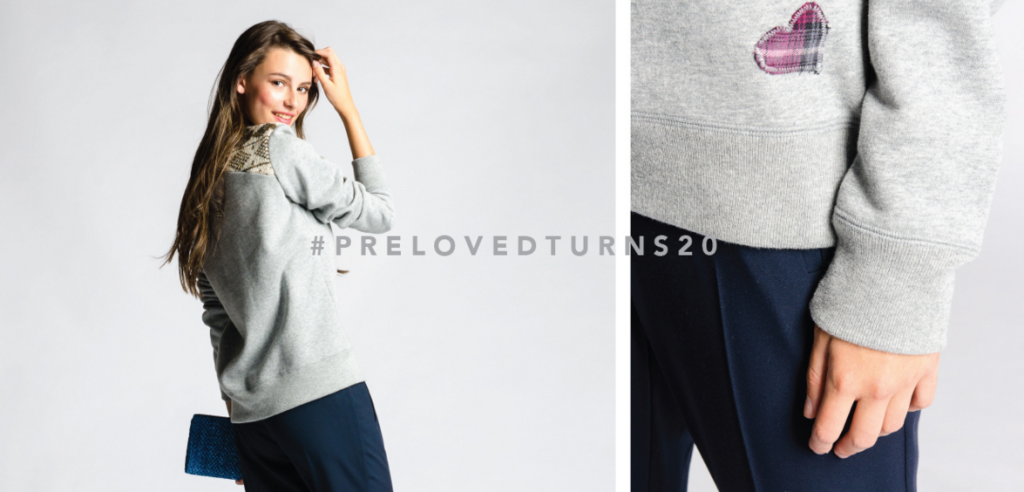
TORONTO – Everything old is new again at Preloved, and the proof is stitched into every garment the Canadian label has produced for the past two decades.
Preloved launched in 1995 and made its imprint on sustainable style by reworking vintage fabrics into new garments. The end result: the teaming of seemingly contrasting pieces to create a cohesive new pattern and design.
The made-in-Canada label also makes use of “dead stock” materials – such as the ends of fabric bolts – which are transformed into fresh fashions, said Preloved founder and creative director Julia Grieve.
Grieve believes consumers are increasingly more educated and conscious about where their garments are produced, as well as the impact that their purchases are having on the planet. But she noted that the desire for trendy, affordable goods is still a major driver behind why fast fashion continues to thrive.
“It’s fashion. It’s very fun, it’s very exciting… So when you can see a T-shirt for $5 and ‘I can get this new outfit.’ It’s like: ‘Oh!’ But again, more awareness will stop that,” said Grieve, a former international model turned entrepreneur.
“You can still get that same high, but maybe we just invest a bit more.”
While Preloved is devoted to producing one-of-a-kind sustainable designs, Grieve is quick to acknowledge the deconstruction and reconstruction of garments isn’t a unique concept.
“Taking something old and making it new again? Hello! It’s the oldest trick in the book. Moms have been doing this for years, taking somebody’s clothing and cutting it up,” Grieve said in an interview at her office, housed within an east-end Toronto factory where her garments are produced.
“But what Preloved is able to do is be able to do that and create clothing that is hanging in some of the best boutiques in the world. It never feels crafty.”
The brand has expanded beyond Canada with a presence in some 400 independent boutiques worldwide. Hollywood leading ladies including Anne Hathaway, Kate Hudson and Julia Roberts have worn Preloved creations.
Preloved celebrated its 20th anniversary with a return to the runway, presenting its latest collection at Toronto’s World MasterCard Fashion Week on Monday.
The spring-summer 2016 line was made up of three distinct collections embodying elements of Canada’s natural landscape.
The presentation opened with Scouts Honour, described as a representation of the “calmness and beauty of Canada’s north” with relaxed silhouettes and a more muted natural colour palette encompassing shades of blue, grey and green.
A bolder more vibrantly hued palette enlivened the Staycation segment, which punctuated its denim designs with colourful hits of tropical floral prints and also showcased patchwork patterning.
The ‘70s boho inspired Desert Rock-themed garments closed out the showcase, with free-flowing, off-shoulder shirts and graphic patterned maxi dresses in the mix.
Grieve brought the party to the runway for the final walk, joining the models with black, white and silver balloons in tow including the numbers “2” and “0” in inflatable numerals.
The commemoration of the anniversary continues away from the catwalk. Grieve said Preloved is also teaming with 20 independent boutiques across Canada to create and curate individual collections.
As Preloved marks a major milestone, Grieve also reflected on the setbacks her company has faced over the years.
In 2008, Preloved lost its downtown Toronto boutique in a six-alarm blaze that gutted an entire city block. In 2012, Grieve said they experienced a huge in-store flood which was “almost impossible to recover from,” resulting in the loss of wholesale orders, patterns, designs and fabrics.
The label bounced back, and more recently, Grieve said the key to success has been through collaborations with larger retailers where they apply the Preloved approach on a grander scale.
“I always say I’ve been mass-producing a one-off for the past 20 years because each piece is unique – but there needs to be consistency to the brand,” said Grieve.
“If you’re selling to large retailers like Holt Renfrew, they don’t like the term ‘assorted.’ The buyer kind of needs to know what she’s going to get. So, we’re able to blend in some new fabrics that can keep the body the same, but add bits of recycled pieces to it so it can show the uniqueness.”